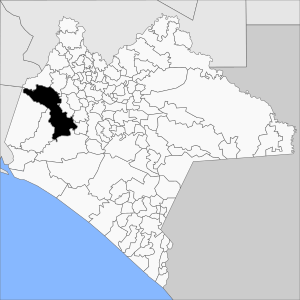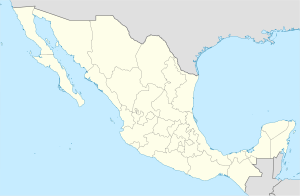Ocozocoautla de Espinosa facts for kids
Quick facts for kids
Ocozocoautla de Espinosa
|
|
|---|---|
 |
|
| Country | |
| State | Chiapas |
| Municipal seat | Ocozocoautla de Espinosa |
| Area | |
| • Total | 2,084 km2 (805 sq mi) |
| • City | 9.39 km2 (3.63 sq mi) |
| Population
(2020 census)
|
|
| • Total | 97,397 |
| • Density | 46.736/km2 (121.045/sq mi) |
| • City | 43,247 |
| • City density | 4,605.6/km2 (11,929/sq mi) |
| Time zone | UTC-6 (CST) |
| • Summer (DST) | UTC-5 (CDT) |
Ocozocoautla de Espinosa, often called Coita, is a town and a municipality in the Mexican state of Chiapas. It is located in the western part of the state. The town is about 24 kilometers (15 miles) west of Tuxtla Gutierrez.
The name "Ocozocoautla" comes from the Nahua language. It means 'forest of ocozote trees'. In 1928, 'De Espinosa' was added to the name. This was to honor Raymundo Enríquez Espinosa. He was the first governor of the state of Chiapas. Ocozocoautla officially became a city in 1926. The area has a warm and humid climate. Most of its plant life is high and medium rainforest.
Contents
People and Population
In 2010, the whole municipality had 82,059 people living there. This was more than the 72,426 people counted in 2005.
The city of Ocozocoautla de Espinosa itself had a population of 39,180 in 2010. The municipality also includes many smaller towns and villages. One of the largest is Ocuilapa de Juárez.
Carnival de Coita: A Fun Festival
The Carnival in Ocozocoautla de Espinosa is a very special event. It mixes old traditions from the native Zoque with Christian customs from Spain. This festival celebrates the start of Holy Week. It also celebrates the idea of new life and the land waking up.
Starting the Carnival Fun
The carnival begins on the Sunday before Ash Wednesday. On this day, special people called cohuinás gather. They are in charge of organizing religious events in the town. They meet before the town's patron saint, Saint John the Baptist. This is how they announce the start of the carnival. The carnival is mainly a big dance festival.
Monday's Big Parade
On Monday, there is a huge parade that lasts about three hours. Different groups compete to be the "best-dressed" or "best-organized." During the parade, people playfully throw talc powder and water on each other. After the parade, people greet the cohuinás. The cohuinás welcome them with chocolate and special breads. These breads are called "pukzinú" (made with cinnamon and squash seeds) and "ponzoquí" (a bread doll cooked on a comal). They also offer distilled spirits to adults.
Tuesday's Traditional Dances
On Tuesday, the cohuinás perform the "Baile de Plaza." This dance is also known as the "Baile Grande" or "Danza del los Enlistaonados." They perform this dance once in each of the town's three main plazas. This dance has very old origins, even before the Spanish arrived. It honors "Tajaj Jama," which means 'Father Sun.'
After the Spanish Conquest, new characters were added to this dance. These include "el Mahoma," an Arab figure who represents evil. There is also David, who represents good and protects his people. "El Caballo" (the Horse) is another character who helps David. In the dance, these characters battle until David wins.
Later on Tuesday, the Dance of the Tiger is performed. In this dance, two tigers and two monkeys (a male and a female) appear. They are joined by a hunter, soldiers, "tatamonos," and "arreadores." The tigers try to hunt the monkeys, while the hunter hunts the tigers. The dance is performed with music from tambourines, marimbas, and flutes. The dance ends when the monkeys win over the tigers, with help from the hunter.
Carnival Continues After Ash Wednesday
Unlike most carnivals, the events in Coita do not stop at midnight on Ash Wednesday. On this day, everyone who took part in the carnival gets "purified." This is done with a "bath" using "zapoyal." Zapoyal is a powder from a yellow, pod-shaped fruit.
On Thursday, there is a special "robbery" ceremony. They "steal" a pig's head that decorated the servant of "el Mahoma." After this, there is a dinner with marimba music. During this event, new people are chosen to play the different roles for the next year's Carnival.
See also
 In Spanish: Ocozocoautla de Espinosa para niños
In Spanish: Ocozocoautla de Espinosa para niños


